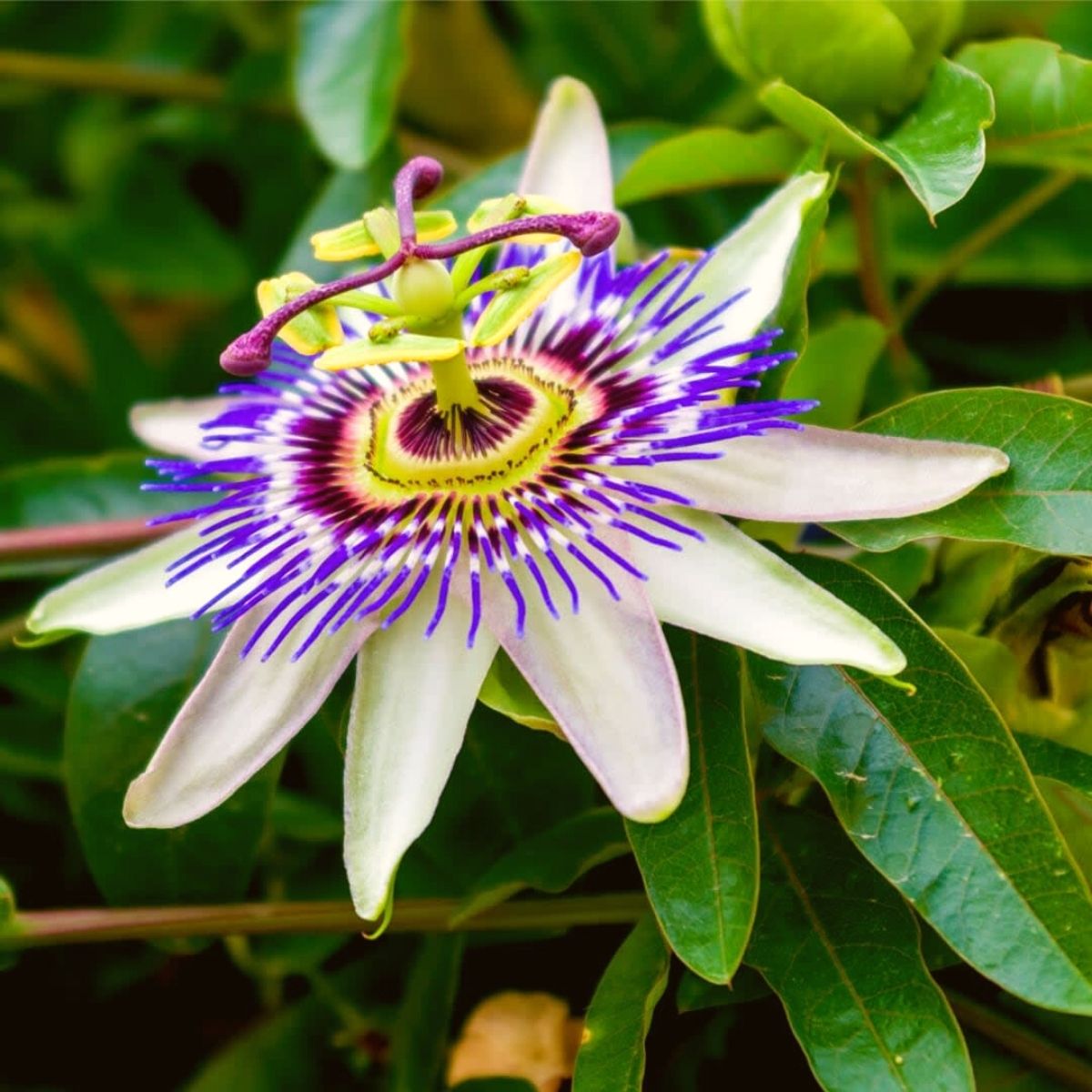Introduction
Passiflora caerulea, commonly known as the Blue Passionflower, is a captivating and versatile plant that belongs to the Passifloraceae family. This perennial vine is renowned for its striking blue and white blossoms, which not only enhance the aesthetics of gardens but also hold cultural and medicinal significance. In this comprehensive guide, we will explore the various facets of Passiflora caerulea, from its botanical characteristics to its uses and cultivation.
Botanical Characteristics
The Blue Passionflower is characterized by its intricate, ornate flowers and distinct leaves. The blooms feature a unique structure with radial filaments and a central corona, contributing to their exotic allure. The plant’s leaves are deeply lobed, adding to its visual appeal. Native to South America, Passiflora caerulea has become popular worldwide due to its distinctive beauty.
Cultural and Medicinal Significance

Beyond its aesthetic charm, Passiflora caerulea holds cultural significance in various regions. The plant’s name is derived from the passion of Christ, as missionaries associated its floral components with elements of the crucifixion. Moreover, Blue Passionflower has a history of use in traditional medicine. Some cultures utilize its parts for their potential calming and sleep-inducing properties, attributed to certain alkaloids present in the plant.
Horticultural Aspects
Cultivating Passiflora caerulea can be a rewarding endeavor for gardeners. The plant thrives in well-drained soil and prefers a sunny or partially shaded location. Adequate support, such as trellises or arbors, is essential for the vine to climb and display its blooms effectively. Gardeners should also be mindful of the plant’s cold tolerance, as it may require protection in colder climates.
Propagation and Care

Propagation of the Blue Passionflower can be achieved through seeds or cuttings. Starting from seeds may take some time, but the process is relatively straightforward. For those seeking a quicker outcome, using stem cuttings with nodes can lead to successful propagation. Regular pruning is recommended to maintain a healthy and manageable plant. Adequate water and proper fertilization contribute to optimal growth.
Ecological Impact
Passiflora caerulea is not only a visually appealing addition to gardens but also plays a role in supporting local ecosystems. The flowers attract pollinators, such as bees and butterflies, contributing to biodiversity. Additionally, the plant serves as a host for specific butterfly larvae, emphasizing its ecological importance.
Passiflora Caerulea – Tips to Grow and Take Care of it
Key facts
| Scientific Name | Passiflora caerulea |
| Common Name | Passion flower, blue passion flower, passion fruit, Jesus flower |
| Plant Type | Perennial vine |
| Native to | South and North America |
| Family | Passifloraceae (Passion-flower Family) |
| Season | Evergreen with pink, blue, white, purple, or red flowers with edible fruit |
| Height | Grows up to 30 feet |
| Watering | One to two waterings a week |
| Light | Direct sunlight to partial shade |
| Ideal growth | Large containers, vertical spaces, trellis or hanging baskets |
| Soil | Well-drained soil |
| Bloom season | Summer |
| Toxicity | Only the ripe fruit is edible |
There are many varieties of passion flowers and all have tropical-looking flowers. The most popular ones are Passiflora caerulea (blue passion flower), Passiflora coccinea (red passion flower), Passiflora incarnata (purple passion flower) and Passiflora alata (fragrant granadilla).
The flowers bloom in early summer until winter. Depending on the variety, some flowers last a day but other varieties may bloom for several days.

Does Passiflora Caerulea need full sun?
Passion flowers can grow in full or indirect sunlight. But they don’t thrive in shaded areas. Passiflora Caerulea needs a minimum of 4 to 5 hours of daily sunlight. Whether you grow your passion flowers indoors or outside, they need full sun with partial shade.

How to take care of your plant?
Soil
:max_bytes(150000):strip_icc()/healthy-soil-and-how-to-make-it-2539853-hero-fdf9b0280dca41cb8ae9614e6fc4a0b0.jpg)
Passiflora Caerulea prefers moist, fertile and well-drained soil. Too much manure or compost results in lush vegetative growth but poor flowering.
Water
Keep the soil moist throughout the summer. Don’t allow it to dry out but ensure it’s not water-logged. You can reduce watering during winter. Overall, the Passiflora Caerulea thrives in moist conditions. Ideally, maintain a less frequent but deep watering routine for a stronger root system.
Pruning
Prune to control the growth and spread of the blue passion flower. The flowers also grow on new growth. Cut the stems just before the blooming time but do not remove any flower buds. Use sharp pruners to avoid tearing the stems.
Fertilizer

Opt for a high-quality fertilizer with balanced nitrogen, phosphorus and potassium ratio. The best is organic compost.
Provide support
As Passiflora Caerulea is a vine, it’s a good idea to place it next to a fence, trellis or any supportive structure, which it can climb. The fast-growing, vigorously climbing vines are covered with dark green leaves. To show off the leafy vines and give a denser appearance, loop them around a wire hoop or trellis.
Common pests and diseases
Passiflora Caerulea prefers high humidity and may develop fungal diseases if the air is not well circulated. The roots may develop fungal diseases if a large amount of top growth is removed at once. Leaf spot, a fungal disease, can occur if the plant is too moist. Remove affected leaves immediately and treat the plant with a fungicide. If kept indoors, the passion flower can be affected by spider mites and whiteflies. Neem oil is the best way to control these indoor pests.
Is Passiflora Caerulea a perennial?
Passiflora Caerulea is indeed a perennial vine with trident-like lobed leaves and strikingly beautiful flowers. The blue and white flowers are about 4-6 inches of active petals, five sepals and violet-blue filament, and green anthers, making passion flowers look beautiful. Blue passion flowers bloom from late summer to early fall. Though it has a fairly long flowering period, the flowers last only for a mere 48 hours, opening at night and slowly closing during the day.
How to grow Passiflora Careulea flower from cuttings?
Passiflora Caerulea can be propagated through seeds but it is commonly done through cuttings. With sharp pruners, take stem cuttings of around 15 cm from the plant. Remove the leaves at the bottom of the cutting, put the cuttings in a pot with moist, well-drained soil and keep it in a warm and humid place. The cuttings should take root within a few weeks.
Can you eat the fruit of Passiflora Caerulea?
Caerulea has an edible passion fruit. They are edible when ripe (orange-yellow) but are usually insipid. Raw fruit can cause health troubles.
What is Passiflora Caerulea used for?
Passiflora Caerulea’s nectar attracts bees. Its fruit is known for flavour and sweetness and has nutritional properties. Passion flower (Passiflora incarnata) is a herbal supplement used for treating anxiety, insomnia, seizures and hysteria.

Passiflora Caerulea – Myth and symbolism
The plant has been unanimously awarded the prestigious Award of Garden Merit (AGM) by the Royal Horticultural Society. Passiflora Caerulea traces its roots to Christian mythology and represents the suffering of Jesus Christ at the crucifixion. The corona of the flower resembles the thorny crown of the thorns of Jesus. In Indian mythology, the passion flower (Passiflora Incarnta) is called The Krishna Kamal. Five sepals signify the Pandavas, 100 corona filaments are the Kauravas and the greenish bulb signifies Draupadi. The three stigmas at the centre depict Brahma, Vishnu and Mahesh (the Hindu Holy Trinity) and a central structure resemble Krishna’s Sudarshan Chakra.
Conclusion
Passiflora Caerulea, the Blue Passionflower, stands as a captivating addition to gardens worldwide, celebrated for its striking blooms and cultural significance. Its intricate flowers, deeply lobed leaves, and cultural ties to the passion of Christ make it a unique and cherished plant. Beyond its ornamental value, the Blue Passionflower offers potential medicinal benefits and plays a crucial role in supporting local ecosystems.
Frequently Asked Questions (FAQs)
1.Does Passiflora Caerulea need full sun?
Passion flowers thrive in full or indirect sunlight, requiring a minimum of 4 to 5 hours of daily sunlight. They don’t do well in shaded areas.
2. How do I take care of Passiflora Caerulea?
Ensure well-drained soil, maintain moist conditions, prune for control, use a balanced fertilizer, and provide support for the vine to climb.
3. Is Passiflora Caerulea a perennial?
Yes, Passiflora Caerulea is a perennial vine, showcasing trident-like lobed leaves and stunning blue and white flowers with a flowering period from late summer to early fall.
4. Can you eat the fruit of Passiflora Caerulea?
The fruit is edible when ripe (orange-yellow), but it’s usually insipid. Raw fruit consumption may cause health troubles.
5. What is Passiflora Caerulea used for?
Passiflora Caerulea’s nectar attracts bees, and its fruit is known for flavor and sweetness. Passiflora incarnata, a related species, is used as a herbal supplement for anxiety, insomnia, seizures, and hysteria.
